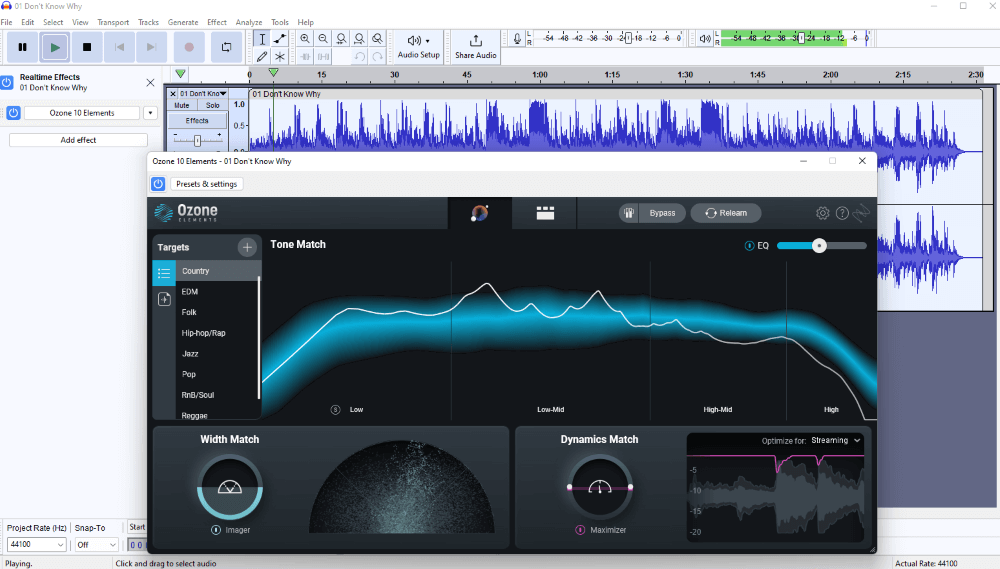If you’re evaluating Digital Audio Workstations (DAWs), you might be considering Audacity. But is Audacity a DAW?
Although Audacity has some amazing and advanced features for a free application, Audacity is not a DAW.
As (DAW applications have improved over the years with features like MIDI and VSTi support, multi-track recording and editing, and the ability to apply effects in real-time, DAWs have risen to essential status among music producers and audio engineers.
I’m Andrew Gilmore, and I’ve been using Audacity for over ten years to record and edit audio. In this article, I’ll break down the key features DAWs have that Audacity lacks. We’ll also look at some features the two have in common, and I’ll answer some frequently asked questions at the end.
Let’s get started.
Table of Contents
What is a DAW?
DAW stands for Digital Audio Workstation. A DAW aims to incorporate all capabilities of a physical music studio into a digital software package.
The key features of any DAW are instrument support, real-time effects processing, multi-track recording and editing, and the ability to mix, loop, and change the tempo of your audio.
Where Audacity Falls Short
With that basic definition in place, let’s point out common DAW features missing from Audacity.
Lack of MIDI Support
The most glaring deficiency in Audacity is its lack of support for MIDI.
Musical Instrument Digital Interface (MIDI for short) is an essential item in any music producer’s toolbox. MIDI instruments and effects allow musicians and producers to conjure up any number of virtual instruments without the need for the physical instrument.
While Audacity can import existing MIDI files, you can’t use the software to edit them, and Audacity cannot record or write MIDI files either. Lacking this feature excludes Audacity from the DAW class of audio software.
No VSTi Support
Since Audacity doesn’t support MIDI, it follows that the free audio editing software would not be able to make use of VSTi plugins.
VSTis are virtual instruments that use MIDI technology to generate the sounds of different instruments. DAWs can use VSTi plugins, but Audacity cannot.
Tempo Detection
The inability to detect and manipulate tempo in Audacity is another limitation. Any standard DAW can detect the tempo of your audio and allow you to dynamically modify your beats per minute (BPM).
Audacity is working on adding BPM support to its software, and some plugins will allow you to detect tempo, but these efforts still pale in comparison to features available in digital audio workstations.
You can change tempo in Audacity, but doing so by BPM requires you to know the original BPM of the recording, and Audacity cannot handle dynamic shifts in tempo (yet). Look for version 3.3–currently in beta–to introduce some more BPM-friendly features.
Features that Audacity and DAWs Have in Common
While Audacity is no DAW, the software has many advanced features for an audio editing application.
These features include support for several types of effects plugins like VST3 and AU. Additionally, Audacity can support some real-time effects so you can apply them non-destructively to your audio.

Additionally, Audacity supports unlimited multi-track recording and editing (limited by your computer’s capabilities). It supports audio interface boxes so you can plug in and capture real instrument sounds directly in the software.
These features set Audacity above most run-of-the-mill audio editors, but because of the above reasons, they still don’t qualify the application as a DAW.
FAQs
Here are some other questions regarding Audacity and Digital Audio Workstations.
Is Audacity good for music production?
In general, Audacity is not a good choice for music production. Lacking MIDI support and tempo awareness will make your efforts painful, if not impossible.
Does Audacity have digital instruments?
No, Audacity does not support digital instruments.
Is Audacity safe?
Yes, Audacity is safe. As an open-source program, you can inspect and even compile the software if you desire.
Is Audacity available for Android?
Audacity is not available for Android. Check out our article for some Audacity alternatives for the Android platform.
Conclusion: More Than an Audio Editor, Less Than a DAW
For a free piece of software, Audacity really is an impressive and useful application to behold. But despite advanced features like multi-track recording, VST3 support, and even some limited real-time effects, Audacity is not a DAW.
As development advances, the software might branch into MIDI and other essential DAW features, but the application is just not there yet.
What’s your favorite DAW? Let us know in the comments!
